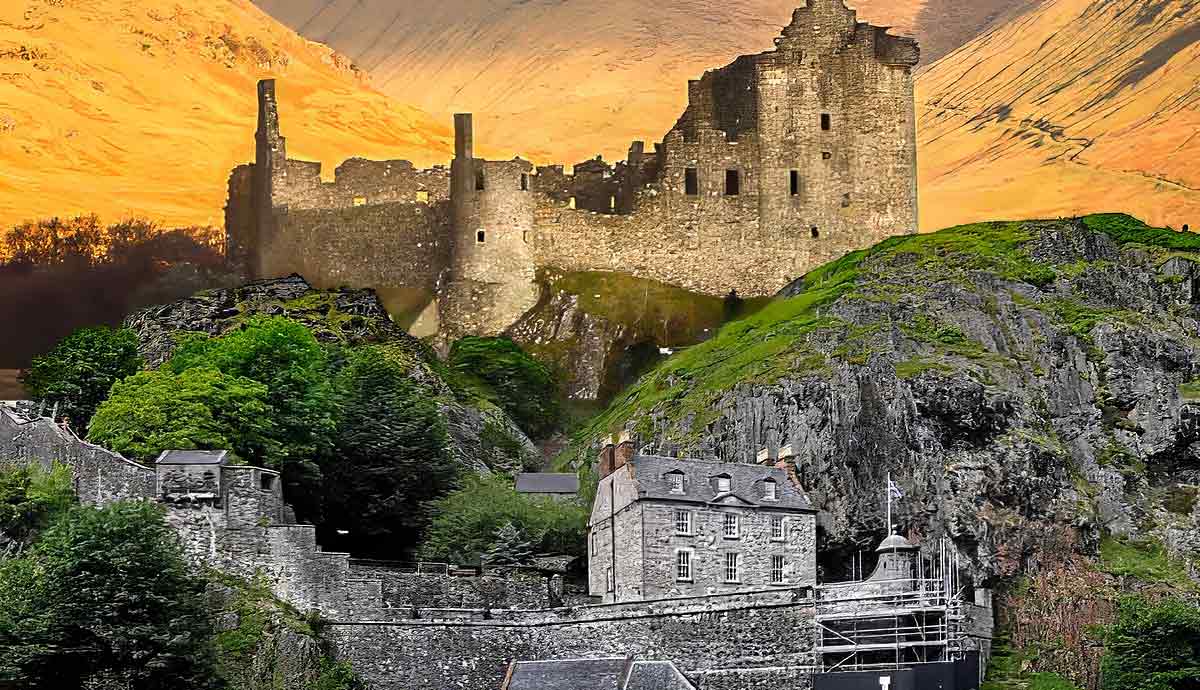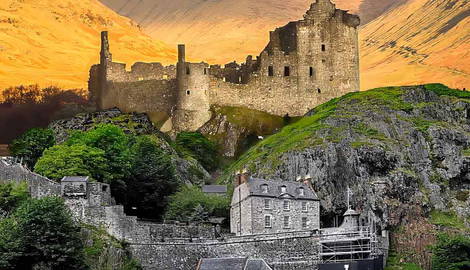
Scotland draws tourists year-round to discover its stunning nature, fantastic views, and rich history. The Isle of Skye is the largest of the Inner Hebrides islands and is famous for its breathtaking views. You can discover the top places to visit on the Isle of Skye here. If you’re traveling there from Glasgow or Edinburgh, you can make the most of the six-hour drive by visiting these seven fascinating and beautiful historical stops.
1. Dumbarton Castle

Your first stop is Dumbarton, a town situated just north of the River Clyde. Here you will find the Rock of Clyde or Dumbarton Rock, which was an active volcano 350 million years ago. The volcanic plug of hardened magma was chosen as the foundation for Dumbarton Castle, the Scottish stronghold with the longest recorded history.
Built in the 5th century CE, Dumbarton Castle was the “Cair Brithon” (the Fort of the Britons). It has several names: “Dùn Breatainn” in Scottish Gaelic, and “Alt Clut” in Welsh. It was the capital of the Kingdom of Brythonic Strathclyde between the 5th and 9th centuries. The castle served as a stronghold against attack repeatedly, starting as early as 756. It was besieged by the Vikings in 871. James the Fat tried and failed to capture it in 1425, burning down the town of Dumbarton in the process. In 1571, during the Marian Civil War, Regent Lennox’s forces scaled the rock with ladders and successfully took control of the castle.

Dùn Breatainn has had many special visitors, including Merlin the wizard (supposedly), Sir William Wallace (following his capture in 1305), and Mary, Queen of Scots in 1563. In 1581, the castle became a prison for Regent Morton as he awaited execution.
The structures that remain today are mostly from the 14th, 16th, and 18th centuries. In summer, it’s possible to visit daily. Visiting times in the winter are more restricted. Take the steps to the Tower Crag for breathtaking views.
2. Kilchurn Castle

From Dumbarton, drive north for an hour, passing Loch Lomond on your right before heading west. Kilchurn Castle sits at the northeastern point of Loch Awe in Argyll and Bute. This magnificent 15th-century castle was built by Sir Colin Campbell, 1st of Glenorchy. It was the first of several castles built by the Campbells, one of the largest and most powerful clans in the Scottish Highlands for over two centuries.
Kilchurn Castle was established around 1450 as a five-story tower house with a small courtyard surrounded by an outer wall. A charter dated March 1449 notes its first existence as “Castrum de Glenurquhay” (the Castle of Glenurquhay). The castle was built on a very small island accessible by a low-lying or underwater causeway. Over the next few hundred years, a “laich hall” (a dining hall), some chambers, and a chapel were added.
The last 100 years of the castle’s life saw quite some drama. Sir John Campbell became the 1st Earl of Breadalbane and Holland in 1681 and, while serving the reigning William III, participated in negotiations with Jacobite rebels. In 1689, the castle became a barracks for 200 men, the oldest surviving barracks on the British mainland.

In 1714, Sir John Campbell held a conference of Jacobites at Kilchurn and joined their uprising the following year, which folded. Castle Kilchurn’s last notable use was as a government garrison in the Jacobite rising of 1745. In 1760, lightning damaged the castle, and it was abandoned. In 1817, the loch waters were lowered, so the castle now sits at the end of a long peninsula.
You can visit the castle during the summer either by boat or on foot (a 10-minute walk). Watch out for highland cattle, which may be roaming the local fields. If you don’t wish to visit the castle but would like to see it, take the A819 to Kilchurn Castle Viewpoint and Layby for breathtaking views across the loch.
3. Oban

Hop in the car for another 40 minutes and drive to Oban, a historical little town packed with character and charm. Its name means “the little bay,” and it sits in a bay shaped like a horseshoe, looking out to the Isles of Kerrera and Mull. It is the seafood capital of Scotland and home to the Oban War and Peace Museum and the Dunollie Museum Castle and Grounds. It is also where you will find the Oban whiskey distillery!
If your time is short, visit the tiny St John’s Scottish Episcopal Cathedral. It is just 19 meters in length, including the nave and chancel. Nevertheless, it is a mesmerizing house of prayer, still in use today.

It was first erected between 1846 and 1864, with subsequent additions in 1882 and 1910. Unfortunately, funds ran out before construction could be completed. In 1920, the name “Church of St John’s, Oban” was retired, and it became known as “The Cathedral of the Diocese of Argyll and The Isles.” The cathedral was designated as “unique,” in light of both its visible phases of construction and its steel girders that are now a permanent support for the incomplete sections of the building.
Unlike many other historical offerings in Scotland, this cathedral is neither grandiose nor spellbinding from the outside. But once inside, the beauty of the painted windows brings its history to life. Park up outside the cathedral or along the bay for a short walk through Oban town.
4. Dunstaffnage Castle and Chapel Ruins

Just 10 minutes from Oban is the Dunstaffnage Castle and Chapel, situated on the south-west entrance to Loch Etive. This is Scotland’s oldest stone castle, built in the 13th century. It still has a hereditary Captain of Dunstaffnage (though not resident at the castle). “Dun” means “fort” in Gaelic, and “staffnage” is from the Norse “stafr-nis,” meaning “headland of the staff.”
Prior to the castle’s construction, Dunstaffnage’s history can be traced back to the 7th century when it was thought to have been a stronghold called “Dun Monaidh” for the Gaelic Kingdom of Dál Riata. In 1612, the Stone of Scone, also known as the Stone of Destiny or Jacob’s Pillow Stone, was kept at the castle. The oblong block of red sandstone was famously used in coronation ceremonies for Scottish monarchs.

The castle was built by Clan MacDougall, who lost it following the Battle of the Pass Brander in 1308. Robert the Bruce seized the castle and, unlike other castles that he sadly destroyed, provisioned and prepared it to guard the seaways and countryside. It was seized again in 1431 by James I after the Battle of Inverlochy. In 1470, James III granted Dunstaffnage to Clan Campbell.
The nearby chapel is also in ruins but still offers some exquisite stonework built in the second half of the 13th century. There is also a castle ghost called the “Ell-maid of Dunstaffnage,” who is a type of brownie or “gruagach,” a hobgoblin-type house spirit that emerges at night to do the house chores.

In 1463, Dunstaffnage was the location of a murderous marriage ceremony. Sir John Stewart, the Lord of Lorn, had an illegitimate son in 1446. To legitimize his son, he planned on marrying his son’s mother, who was a MacLaren. On his way to the church, he was stabbed. He just about made it through the ceremony before passing away. His son was legitimized and became the First Chief of Appin.
The castle is open to the public year-round, with limited opening times over winter. It offers beautiful views and an easy wander about the interesting quadrangular structure and grounds. The 16th-century gatehouse remains private, belonging to the Captain of Dunstaffnage.
5. Castle Stalker

Take a scenic 30-minute drive away from Dunstaffnage Castle over Connel Bridge and up alongside Loch Creran, through local towns and villages. When you arrive, you’ll be greeted by a spectacular view of Castle Stalker, one of the best-preserved tower houses from the medieval period, dating back to 1320. This castle also has a close history with Dunstaffnage, and many scuffles, murders, and fights occurred between clans occupying the two castles.
Originally built as a small fort by Clan MacDougall, the castle stands alone on a small tidal islet, which is just about possible to reach during low tide. Sir John Stewart, the Lord of Lorn, who was attacked moments before his wedding, transformed the castle in the 1440s. King James IV of Scotland often visited Castle Stalker in the late 1400s, using it as a base for hawking and hunting in the Highlands. Stalker in Gaelic is “Stalcaire” and means “hunter” or “falconer.”

The castle later fell into the hands of Clan Campbell following a drunken bet in exchange for an eight-oared wherry (a traditional canal or river boat used for transporting passengers or cargo). Castle Stalker was abandoned in 1840, and although some conservation efforts were made in the early 1900s, it was only in 1975, following a 10-year restoration project, that it was restored to its full glory.
The castle is privately owned; however, public visits are possible during the summer months via tours, which must be booked in advance. Castle Stalker is ideal for a quick pit-stop viewing, as it is quite a spectacular sight from the shoreline.
6. Clan Cameron Museum

Just over an hour north of Castle Stalker is the Clan Cameron Museum, dedicated to the Cameron family whose history dates back to the 14th century, spanning 27 generations. The museum is small yet packed with fascinating information, including details on the clan’s involvement in various military events, such as the 1745 Jacobite uprising. The museum documents the historic military training of the 79th Cameron Highlanders and the Commandos from around the world who fought in WWII.
The local village of Achnacarry was of strategic importance during many wars and uprisings. It is a gateway to many beautiful nature walks. The museum itself is set in an old post office building and was first opened by Sir Fitzroy Maclean of Dunconnell in 1989. It offers a rather enchanting insight into the life of the clansfolk of the Scottish Highlands. The museum is open daily during summer, and visits can be made by appointment during winter.
7. Invergarry Castle

The final stop on your journey to the Isle of Skye is the ruin of Invergarry Castle, around 40 minutes north of the Clan Cameron Museum. Built relatively recently, according to local clan law, Invergarry Castle came to life with the help of clansmen passing stones hand-to-hand.
In its heyday, Invergarry Castle stood as a striking L-plan tower house, consisting of six stories. Sadly, it was burned to the ground in 1654 by Oliver Cromwell’s army during the English Civil War. Following repairs, King James VII of Scotland held the Castle from 1688 until 1692. It was briefly held by the Jacobites during their 1715 uprising and later in 1745 during their second uprising. The castle succumbed to an attack following the Battle of Culloden in 1746, and although it was sacked and blown to bits, the walls stood tall and defiant. They remain largely intact to this day.

Interestingly, the castle’s design was somewhat outdated even at the time it was constructed. Technically, the castle isn’t a fortified building but more of a country house, which partially explains why it did not survive the ruthless sacking it endured at the end of the 1700s.
The castle’s remaining north staircase collapsed in 2000, prompting conservation works. Today it stands tall on the banks of Loch Oich, within the grounds of the Glengarry Castle Hotel. The castle itself is fenced off for safety reasons, so park up and wander down to the shores to get a look at both the ruins and the sunken boat just off the shoreline.
Once you’ve finished here, head west, and in just over an hour, you’ll cross the Skye Bridge and will have arrived on the Isle of Skye.









